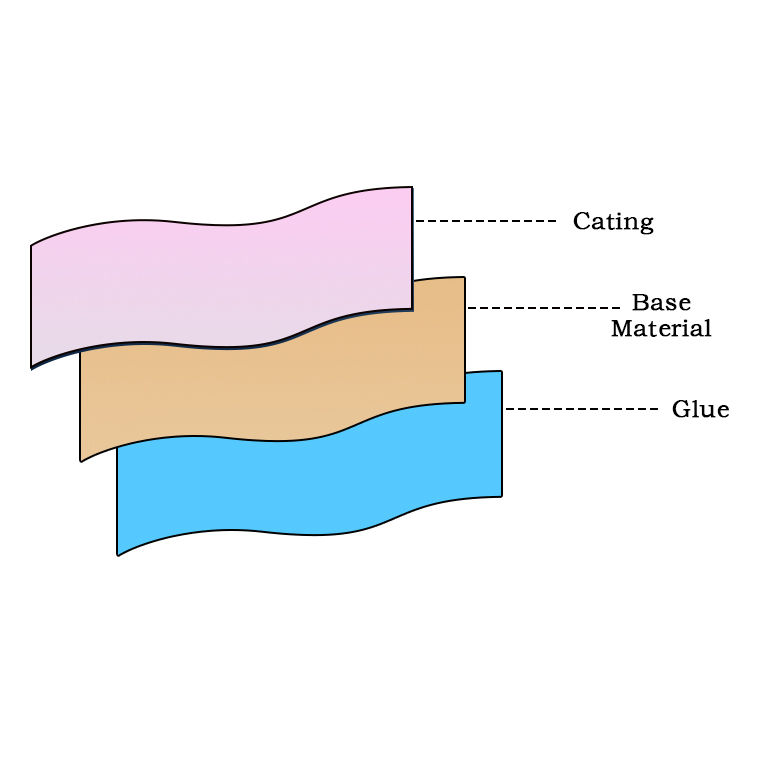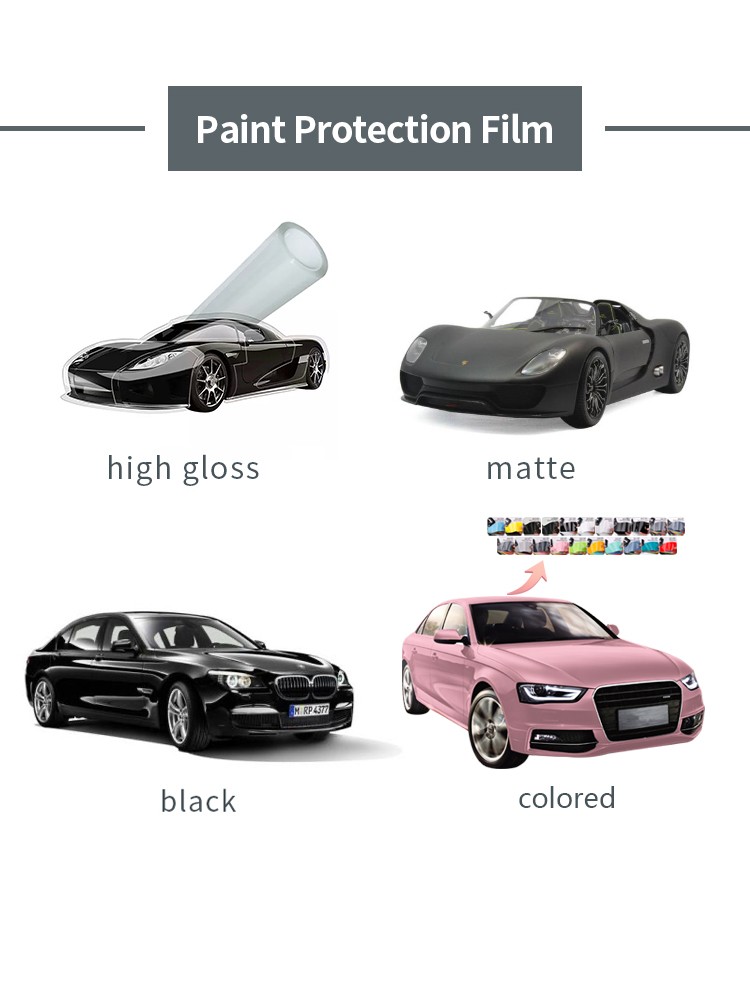One of the most popular benefits of PPF film of TPU, in addition to great protection capabilities, is increased brightness for cars.Why do some cars have obvious brightening effect with car paint protrction film of TPU, while others appear dim? When selecting the paint protrction film of TPU, are glossiness and haze interchangeable terms? What is the relationship between the two? How to choose the index?

Glossiness is a physical characteristic that measures a surface’s capacity to reflect light under specific geometric circumstances. Therefore, it incorporates direction selection to represent the reflection characteristic. Coatings can be categorized into bright, matte, dim, and other glossiness levels.
The modest roughness of an object’s surface might be thought of as glossiness. In other words, the smoother the surface, the more reflecting it is, and the perceived brightness increases, demonstrating that the glossiness is higher.
The amount of transmitted light intensity that deviates from incoming light at an angle more than 2.5 degrees to the total transmitted light intensity is referred to as haze. We can think of haze as having the capacity to disperse light, in general. The light is dispersed, as seen in the illustration.
Haze is a significant optical transparency parameter for car paint protection film. The more the haze, the greater the light-scattering ability, which decreases the film’s brilliance and transparency, especially the imaging degree, and renders it undetectable to human eyes.
Gloss and haze, in general, have no connection to one another. Haze is a visual representation of how light is scattered by car paint protective film. The surface of the paint protective film might reflect light depending on how glossy it is. The two have completely different amounts to test.

Glossiness&haze indexes
Glossiness and haze both have an effect on how brightening automobile paint turns out, and both must reach a particular level to work their best. While there is a brightening impact when the glossiness and haze are both high, the color of the car paint will appear distorted. If the haze and glossiness are both low, however, the brightening effect is not as noticeable.
So, what are the glossiness and haze indexes measured by? Is there a standard?
The difference between the glossiness of various car paint protection film or the difference between the glossiness of the car paint before and after film pasting can be precisely determined via a glossiness meter since it is simple to have deviation by visual inspection; Similar to that, the car paint protection film ‘s haze may also be found with the haze meter.
In accordance with the standard proposed in Paint Protection Film, bright car ppf films are divided into Grade A and Grade B according to glossiness, with Grade A glossiness ≥ 140 and Grade B glossiness ≥ 110 and < 140. In terms of haze, the haze of ppf film is ≤ 1%.
Influencing factors of glossiness & haze
In addition to the PET protective layer that needs to be torn off during installation, car ppf film of TPU is mainly composed of three layers: coating, substrate and glue.
Glossiness refers to a surface’s capacity to reflect light, hence the coating primarily determines how glossy a car cover film of TPU is.
Glossiness is closely related to the roughness of coating surface. The smaller the roughness of the surface of an object, the more light it reflects and the higher the glossiness. On the contrary, if the surface of an object is uneven, the scattered light will increase, resulting in a decrease in glossiness. The surface roughness of bright objects perceived by human vision, when the surface roughness h of objects is greater than 1.1 μ m, it will be uneven and the glossiness will decrease.
Pursuant to the glossiness of the coating, it can be divided into matte paint protection film and high gloss paint protection film, and matte can also be divided into low matte and high matte. However, the bright paint protection film has various glossiness.
There are two main factors affecting coating roughness and glossiness:
Coating: The coating must fulfill various functions, such as stretch ability, impermeability, repair ability, aging resistance, acid and alkali resistance, hydrolysis resistance, etc. These qualities are achieved through the application of different coating solutions, and the glossiness of coating solutions with varied formulations varies after the automotive PPF film has been fabricated.
Coating processing conditions: Coating development is extremely crucial for surface roughness and glossiness. Coating is applied to the multi layer structure of PPF film, which consists of functional coating, TPU base film, and pressure sensitive adhesive. The coating procedure may be separated into two processes: gluing and functional layer process, and then it must rest for 12 to 24 hours to mature so that the glue and raw materials can bond completely, resulting in a more stable performance. Coating procedures include micro-concave coating, slit extrusion coating, comma scraper coating, gravure coating, and reverse contact coating. Different coating glosses will undoubtedly result from the adoption of various processing techniques. In addition, coating thickness, the leveling characteristic of the coating solution, temperature, etc. will impact the quality of the coating. The regulation of these elements necessitates extremely advanced technology, and the glossiness of automobile paint protection films manufactured in factories with immature coating technology will be drastically diminished.

Haze reflects the light scattering ability of the entire car cover film, and the percentage of TPU substrate in the ppf film can reach 70%. TPU substrate determines haze in a specific sense.
TPU:TPU is primarily separated into aromatic TPU with low yellow resistance and aliphatic TPU with high yellow resistance based on the different types of diisocyanate. TPU can be categorized into polyester, polyether, polycaprolactone, and polycarbonate types based on the different types of polyols. In terms of transparency, polycaprolactone type > polyester type > polyether type. This is another significant factor why we have always stressed the necessity of employing polycaprolactone aliphatic TPU for car protection film. In addition, antioxidants, light stabilizers, hydrolysis stabilizers, and other additives will be added to TPU during production to meet the stringent performance requirements of the automobile coat film. Different ratios of additives will also impact the translucency of TPU particles and, in turn, the haze of the vehicle coat layer.
TPU Processing conditions:TPU particles are adopted to create TPU film through procedures such as calendering, tape casting, blowing, and coating. Different production procedures directly affect the material orientation and stability of TPU films.
Surface state:Haze is affected by the flatness and smoothness of the car cover film’s surface, the presence of abrasions and imperfections, and whether or not it is contaminated.
Thickness:The increase in thickness will result in an increase in light absorption and scattering, leading to a rise in haze. Because TPU is difficult to evenly plasticize and the film is elastic, the process control precision is quite high.

KOTINT selects famous TPU basement film suppliers, which require high transparency, good flatness, excellent performance and outstanding mechanical properties, and are widely recognized by automobile paint protection enterprises.




